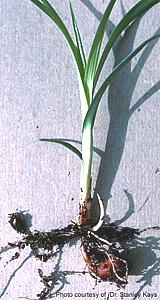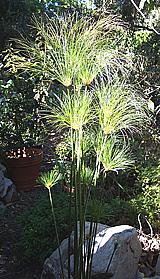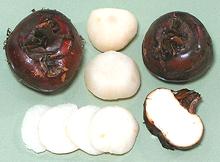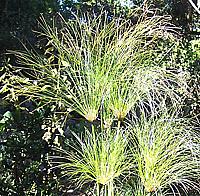
SAFARI
Users
Varieties
Chufa
 [Nut Grass, Tiger Nut, Earth Almond; Aya (Hausa); Ofio (Yoruba);
Chufas (Spanish); Cyperus esculentus varieties]
[Nut Grass, Tiger Nut, Earth Almond; Aya (Hausa); Ofio (Yoruba);
Chufas (Spanish); Cyperus esculentus varieties]
Chufa is a sedge that grows in many parts of the U.S. and Canada where there are mud flats or similar rich grounds. It has been cultivated in North America and Europe for it's edible tubers, sometimes called "Earth Almonds", which are harvested mainly in the late fall and dried. The tubers are small, up to 1/2 inch diameter. They are high in fiber, starch, fat, sugar and protein, contain minerals, mostly phosphorus and potassium, and vitamins C and E. They are high in oil which is 82% monounsaturated and polyunsaturated, and 18% saturated. The oil content is so high this plant is being considered as a source of biodiesel.
Chufa was farmed in ancient Egypt as a food crop and taken much later to other Mediterranean areas by invading Muslims. Today it is particularly cultivated in Valencia, Spain where it is used to make a non-alcoholic beverage called Horchata. The tubers are a popular snack in West Africa, and are ground into flour to be added to baked goods. As in Valencia, they are used to make non-alcoholic beverages.
In North America, Chufa has been grown mainly for hog forage and not
as a commercial crop, but now it is being promoted as a "super-food"
under the name Tiger Nuts. Actually, I always thought tigers had bigger
nuts than this.
Photo courtesy of Dr. Stanley Kays, attribution required.
Papyrus
 [Cyperus papyrus]
[Cyperus papyrus]
While no longer much used as a food plant, Papyrus is an interesting part of the sedge family. It illustrates the growth habit of many sedges with a long triangular pith filled reed, topped by a splay of thread-like rays forming the flower head. Sedges may have grass-like leaves growing at the base of the reed but in papyrus the leaves are reduced to short paper-like scales. Pith from the stems of young plants can be eaten raw or cooked. The roots are woody and not edible.
Pith from papyrus reeds was used for thousands of years by ancient Egyptians for the manufacture of a form of paper of the same name. This resulted in ancient Egypt being both the most literate and most paper ridden society previous to modern times. "Please fill out Papyrus-A using hieratic characters only, no demotic script please, and present it to the scribe at desk 12 who will provide you with the mummification request forms."
While they are aquatic plants (as most sedges are) my papyrus plants
are doing quite well in a regular pot and have survived strong dry Santa
Ana winds with only minor damage. They are frost tender but that's seldom
a problem here in Los Angeles, especially with global warming setting in.
Water Chestnut
 [Chinese Water Chestnut; Biki (China); Apulid (Philippine); Cu ma they,
Cu nang (Viet); Somwang (Thai); singhada (India);
Eleocharis dulcis]
[Chinese Water Chestnut; Biki (China); Apulid (Philippine); Cu ma they,
Cu nang (Viet); Somwang (Thai); singhada (India);
Eleocharis dulcis]
Water Chestnuts are native to China, Japan, India and Southeast Asia, Water Chestnuts are native to China, Japan, India and Southeast Asia, the Philippines, Australia, Pacific Islands and tropical Africa. They are extensively farmed in Southern China and the Philippines, where they grow well in flooded rice paddies and lotus ponds.
Mature plants produce the underground "corms" we call Water Chestnuts
as a means of propagation. Their crunchy texture and slight sweetness
are appreciated in soups and stir fries. A notable feature is that they
remain crisp and crunchy even after cooking or canning, making them
a good texture accent.
Details and Cooking.
 [Family Cyperaceae]
[Family Cyperaceae]



